Two decades have passed since South Korean troops were dispatched to East Timor, officially known as Timor-Leste, on peacemaking operations in the newly independent country.
While the Evergreen Unit of South Korea was stationed in East Timor from 1999 to 2003 to help it settle as an independent nation, traces of the troops’ legacy remain.
When South Korea’s delegation from the Defense Ministry visited the country to commemorate the 20th anniversary of the deployment of the Evergreen Unit last week, young adults and children demonstrated taekwondo, a Korean martial art that the peace keepers taught them years ago.
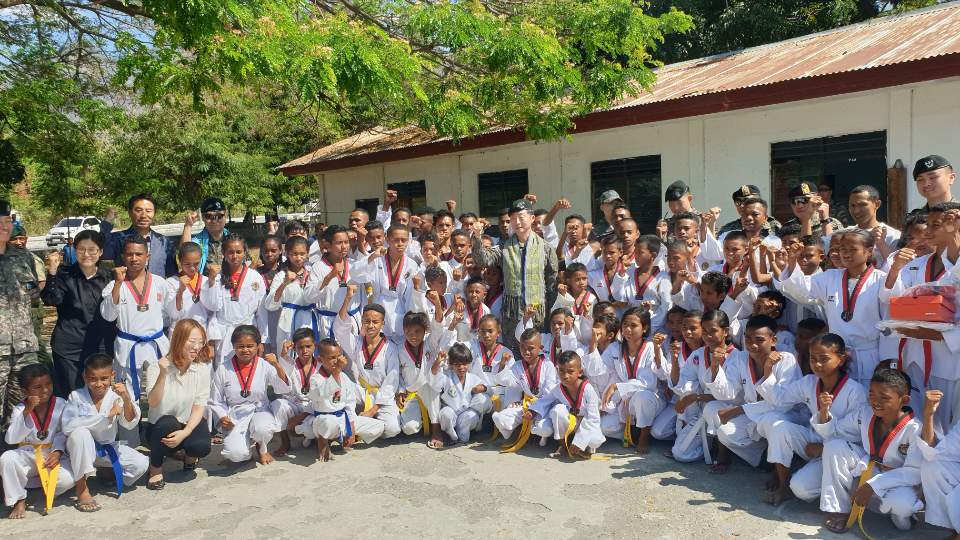 |
East Timorese children in Taekwondo uniforms pose with South Korea’s delegation in Lospalos, East Timor, on Oct. 6. (Embassy of the Republic of Korea in East Timor) |
The coffin that was prepared by the country for a missing South Korean soldier 16 years ago, was still placed inside an old police station, awaiting his return.
“When I was deployed for the peacekeeping mission in 2001, it was right after East Timor had gained independence, and the country was in a devastating situation,” Lt. Gen. Lee Seok-gu, the president of Korea National Defense University, told The Korea Herald. “The country has changed so much compared to then.”
Lee, who was deployed to East Timor in 2000 for seven months as part of the Evergreen Unit, returned to the country again with a Korean delegation from Oct. 5-8 for the commemorative event.
Legacy of civil-military operations
Before it came under Indonesian rule in 1975, East Timor had been occupied by Portugal for 452 years. When Portugal abandoned its colonies amid internal strife, the neighboring Indonesia immediately took over East Timor and occupied it for the next 25 years.
Following a continued struggle for independence, East Timor held a UN-supervised referendum in 1999, which showed overwhelming support for the country’s independence from Indonesia.
Violent clashes ensued between those supporting independence and the pro-Indonesian militia, and Australia organized a non-UN multinational International Force East Timor to prevent further bloodshed.
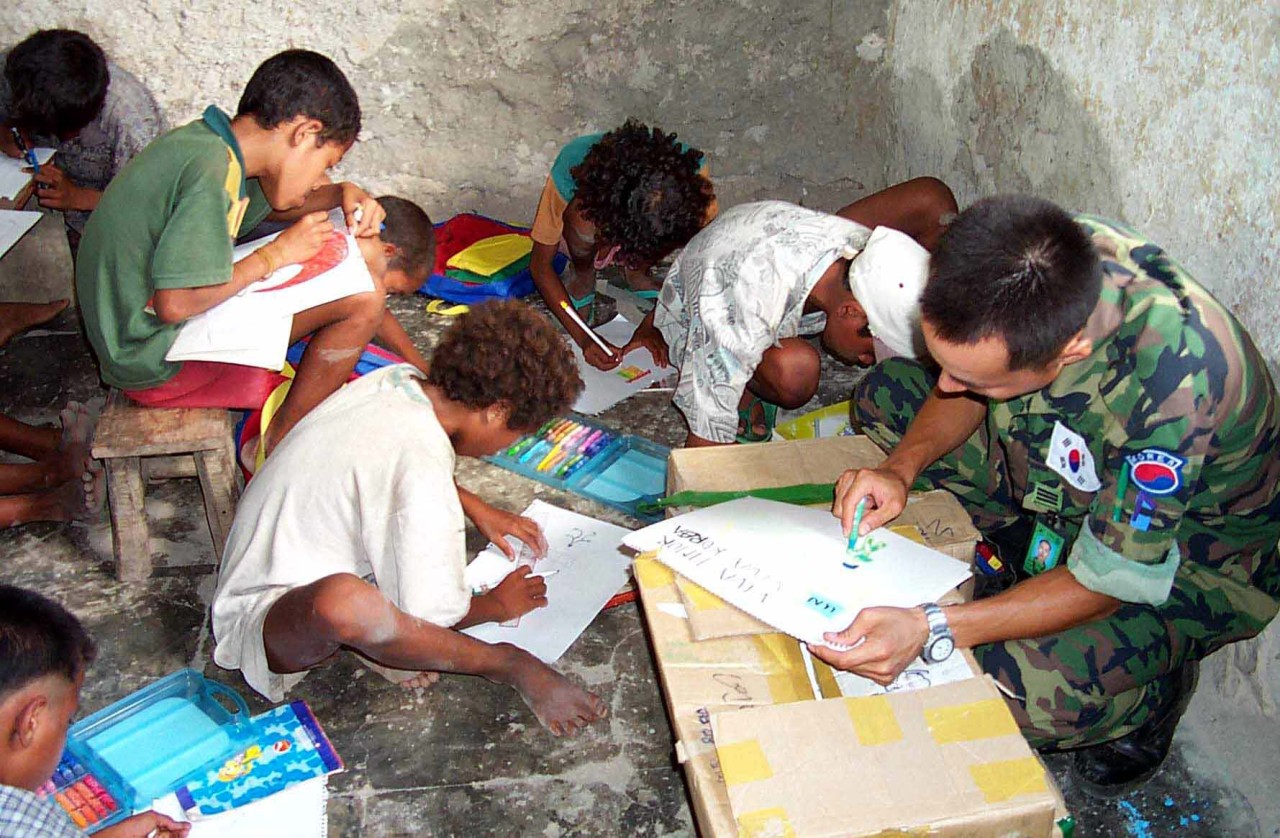 |
A South Korean soldier draws on a sketchbook with East Timorese children during his service in East Timor as part of the Evergreen Forces in the early 2000s. (The Korea Defense Daily) |
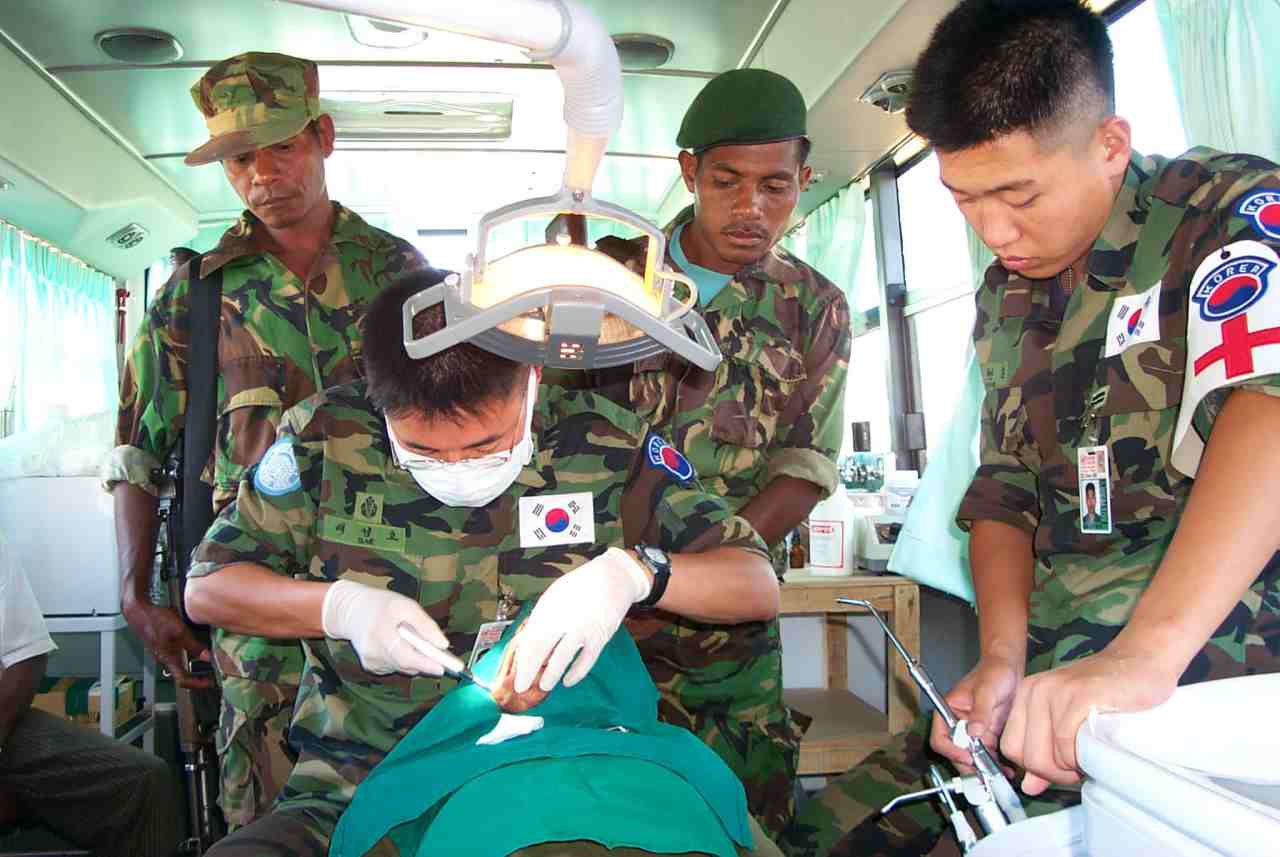 |
Korean soldiers provide dental care to East Timorese during their service with the Evergreen Forces in East Timor in the early 2000s. (The Korea Defense Daily) |
Upon request from Australia, South Korea also participated in the international peacekeeping task force that also involved New Zealand, Canada and the US. During the period from September 1999 to October 2003, South Korea sent a total of 3,212 troops.
While the Evergreen Unit was not the largest in size, it built one of the strongest ties with the East Timorese.
“There were over 20 other countries that deployed peacekeepers here in East Timor. But the people here really appreciate the work of the Evergreen Unit,” South Korean Ambassador to East Timor Lee Chin-bum told The Korea Herald.
The civil-military operations of the Evergreen Unit were widely recognized as the best among the multinational forces by the local population. The South Korean troops rebuilt destroyed bridges and roads, and provided medical treatment and haircuts for civilians. They also opened computer and taekwondo classes for the children.
According to the Korean Embassy, there are over 5,000 people learning taekwondo across East Timor, 20 years after the sport was first introduced.
“I remember there were less than 100 people learning Taekwondo when we first taught. It was touching to see people on the streets wearing the white uniforms and greeting us in Korean,” said Lt. Gen. Lee.
On their visit, the South Korean delegation donated 22 computers and delivered 200 sets of Taekwondo uniforms and 50 pairs of shoes for Taekwondo trainees in Dili, the capital city, and Oecussi, according to the Defense Ministry here.
Lt. Gen. Lee said their strong connection with East Timorese came as the countries shared a “similar” history of colonization. South Korea also struggled hard to achieve independence under Japan’s ruling from 1910 to 1945.
“I think our sincerity and empathy was delivered to the people of East Timor. South Korea was also in ruins after (colonization) and the Korean War. But with help from the United Nations and the international society, we became a country with a strong economy,” Lt. Gen. Lee added.
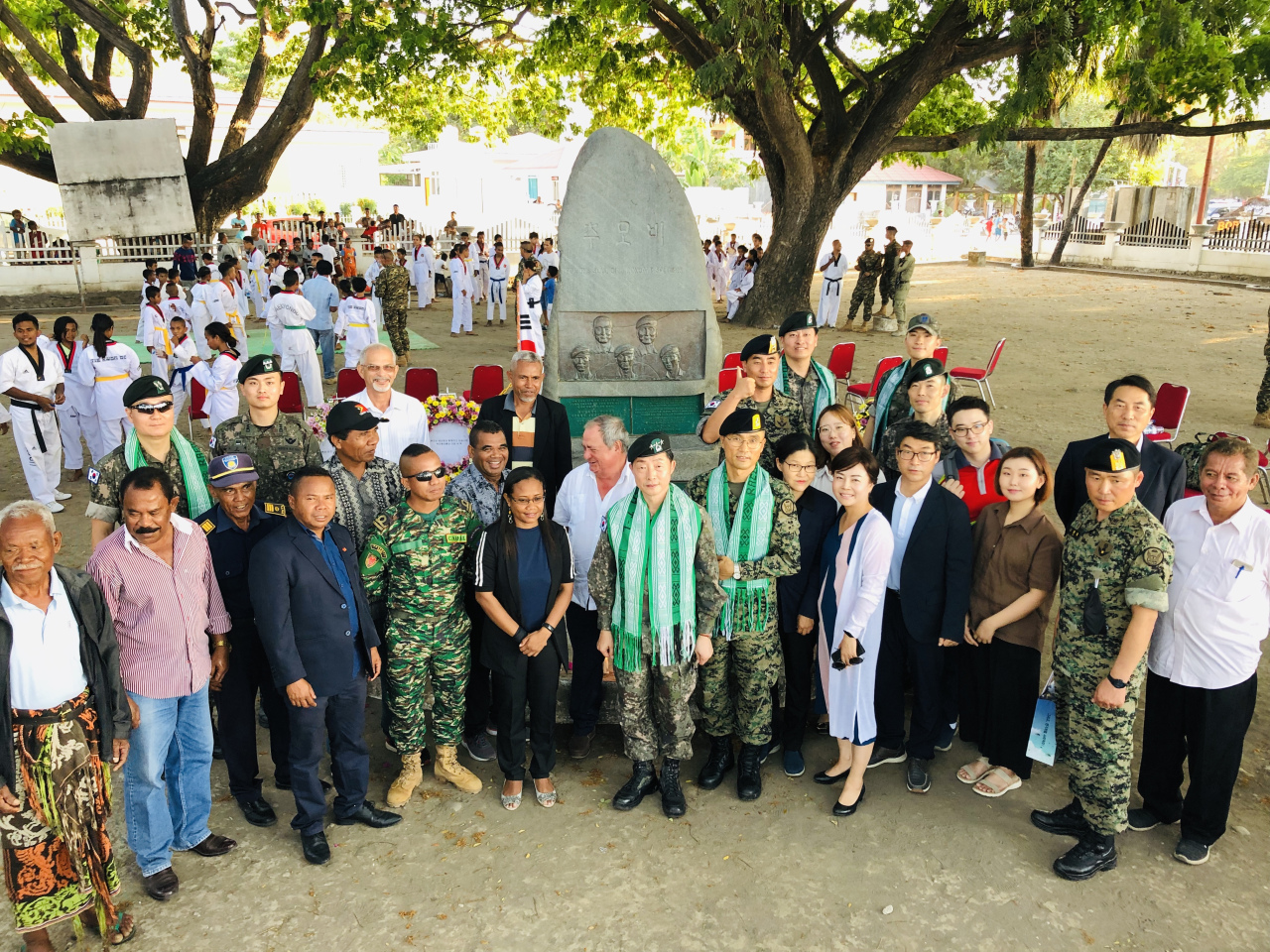 |
A South Korean delegation poses for photos during 20th anniversary celebrations in October. (Embassy of the Republic of Korea in East Timor) |
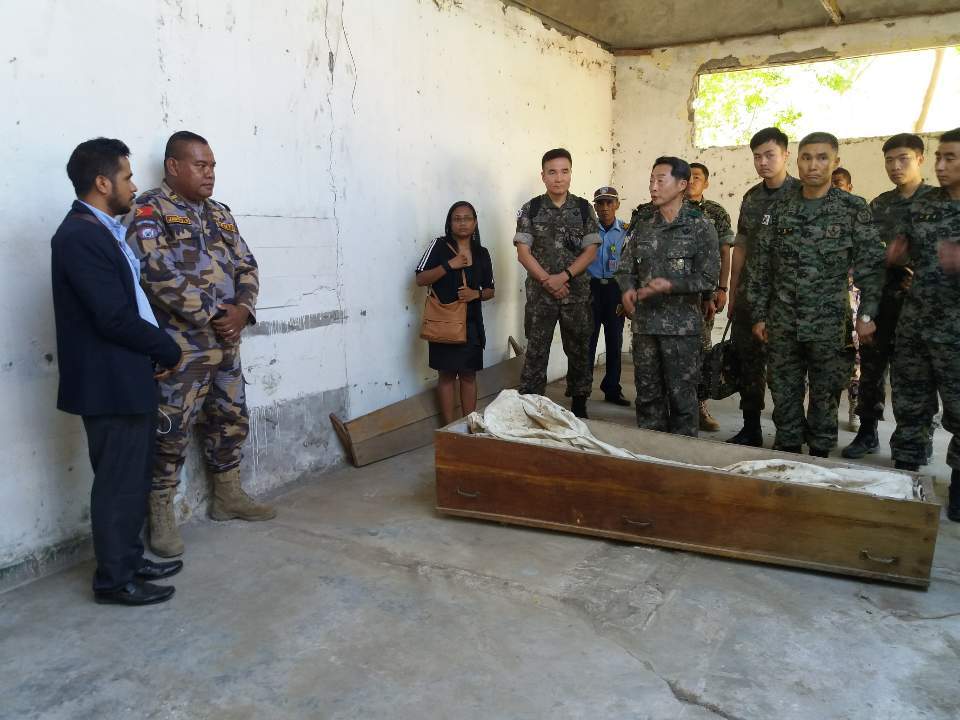 |
A South Korean delegation views the casket prepared for a soldier who went missing in a flood in 2003, on Oct. 6. (Embassy of the Republic of Korea in East Timor) |
During their visit, the delegation also paid tribute to the five fallen Korean soldiers who were swept away in strong currents in Ekat River in Oecussi in March 2003. Four Koreans died in the accident and one is still missing.
Inside the old building that was used by the Evergreen Unit in Ouecussi, the coffin that was prepared for the missing South Korean soldier remains where it was placed more than a decade ago. On a shoreline, a memorial stone stands to commemorate the soldiers.
Economic independence
“We helped them as East Timor sought to achieve political independence, and I hope South Korea will also help the country for its economic independence,” Ambassador Lee said.
With the help of the UN and the multinational forces, East Timor was officially recognized as an independent state in 2002. It has been 17 years since then, and the country struggles with high unemployment and lack of industries.
In his post for some two years, Ambassador Lee wishes for more support for East Timor.
Lee wrote to some 170 companies in South Korea explaining about East Timor, so that Korean employers would choose to hire workers from East Timor. South Korea operates the Employment Permit System under which low-skilled workers from 16 countries are allowed to work in the country. East Timor is one of those countries but because it is relatively unfamiliar to Koreans, East Timorese workers are often not chosen by the employers, Lee explained.
“There are also over 8,000 people waiting to learn the Korean language, but the capacity of the institutes here can only teach up to 1,800 people a year,” Lee said.
Lee also suggested that it would be good to make use of the old facilities and Taekwondo studios that the South Korean forces used, as they have been left untouched since the troops left.
The Taekwondo studio still has a sign that says “Evergreen Unit” in faded Korean letters. Inside, the whiteboard that was used at the time still has the timetable written more than a decade ago.
South Korea would be a good example for East Timor, as the two countries suffered from similar hardships from colonization, said Lt. Gen. Lee.
“It would be very meaningful for us, and the international society to aid East Timor to stand strong on its own. It is a country that gained independence for the first time in the 21st century, after all,” he said.
By Jo He-rim (
herim@heraldcorp.com)








![[Herald Interview] 'Trump will use tariffs as first line of defense for American manufacturing'](http://res.heraldm.com/phpwas/restmb_idxmake.php?idx=644&simg=/content/image/2024/11/26/20241126050017_0.jpg)

![[Health and care] Getting cancer young: Why cancer isn’t just an older person’s battle](http://res.heraldm.com/phpwas/restmb_idxmake.php?idx=644&simg=/content/image/2024/11/26/20241126050043_0.jpg)

